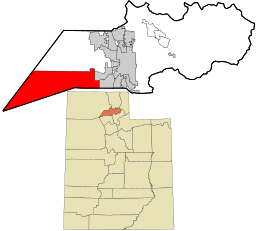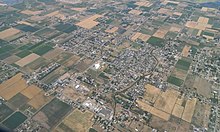Hooper, Utah
Hooper, Utah | |
|---|---|
 Monument at the site of the first house built in Hooper in 1854 | |
 Location in Weber County and the state of Utah | |
| Coordinates: 41°09′30″N 112°15′24″W / 41.15833°N 112.25667°W | |
| Country | United States |
| State | Utah |
| County | Weber |
| Settled | 1854 |
| Incorporated | November 30, 2000 |
| Founded by | William Henry Hooper |
| Area | |
| • Total | 87.99 sq mi (227.90 km2) |
| • Land | 26.10 sq mi (67.60 km2) |
| • Water | 61.89 sq mi (160.30 km2) |
| Elevation | 4,196 ft (1,279 m) |
| Population (2020) | |
| • Total | 9,087 |
| • Density | 100/sq mi (40/km2) |
| Time zone | UTC-7 (MST) |
| • Summer (DST) | UTC-6 (MDT) |
| ZIP code | 84315 |
| Area code(s) | 385, 801 |
| FIPS code | 49-36400[3] |
| GNIS feature ID | 2410790[2] |
| Website | www |

Hooper (/ˈhʊpər/ HUU-pər) is a city in Weber County, Utah, United States, first called Muskrat Springs and later Hooperville for Captain William Henry Hooper,[4] an early Utah delegate to Congress. The population was 9,087 at the 2020 census, up from the 2010 figure of 6,932. Prior to the city's incorporation on November 30, 2000, Hooper was an unincorporated census-designated place (CDP).
Hooper is part of the Ogden–Clearfield, Utah Metropolitan Statistical Area.
History
[edit]Hooper was settled in 1854, and become a township in 1997 (about 15 years after a failed vote to incorporate). Over the next several years "it became evident that the township board could make plans and suggestions, but had no official power," so a vote to incorporate passed on May 2, 2000, with the city being officially incorporated on November 30, 2000.[5]

Geography
[edit]According to the United States Census Bureau, the CDP has a total area of 11.7 square miles (30.3 km2), of which 11.5 square miles (29.9 km2) is land and 0.2 square mile (0.4 km2) (1.45%) is water.
Fremont Island in the Great Salt Lake is included in this city's boundary. On March 30, 2007, Glenn Barrow became the first Hooper mayor to visit the island in the city's brief history.[6]
Demographics
[edit]| Census | Pop. | Note | %± |
|---|---|---|---|
| 1880 | 849 | — | |
| 1890 | 778 | −8.4% | |
| 1900 | 886 | 13.9% | |
| 1910 | 823 | −7.1% | |
| 1920 | 859 | 4.4% | |
| 1930 | 911 | 6.1% | |
| 1940 | 1,020 | 12.0% | |
| 1950 | 1,243 | 21.9% | |
| 1990 | 3,468 | — | |
| 2000 | 3,926 | 13.2% | |
| 2010 | 7,218 | 83.9% | |
| 2020 | 9,087 | 25.9% | |
| 2023 (est.) | 9,369 | 3.1% | |
| Source: U.S. Census Bureau[7] | |||
According to the 2020 United States census[8] and 2020 American Community Survey[9], there were 9,087 people in Hooper with a population density of 192.0 people per square mile (74.1/km2). Among non-Hispanic or Latino people, the racial makeup was 7,967 (87.7%) White, 44 (0.5%) African American, 27 (0.3%) Native American, 67 (0.7%) Asian, 12 (0.1%) Pacific Islander, 25 (0.3%) from other races, and 226 (2.5%) from two or more races. 719 (7.9%) people were Hispanic or Latino.
There were 4,633 (50.98%) males and 4,454 (49.02%) females, and the population distribution by age was 2,967 (32.7%) under the age of 18, 5,169 (56.9%) from 18 to 64, and 951 (10.5%) who were at least 65 years old. The median age was 33.6 years.
There were 2,581 households in Hooper with an average size of 3.52 of which 2,275 (88.1%) were families and 306 (11.9%) were non-families. Among all families, 1,992 (77.2%) were married couples, 126 (4.9%) were male householders with no spouse, and 157 (6.1%) were female householders with no spouse. Among all non-families, 240 (9.3%) were a single person living alone and 66 (2.6%) were two or more people living together. 1,289 (49.9%) of all households had children under the age of 18. 2,453 (95.0%) of households were owner-occupied while 128 (5.0%) were renter-occupied.
The median income for a Hooper household was $100,347 and the median family income was $110,500, with a per-capita income of $33,243. The median income for males that were full-time employees was $74,708 and for females $46,211. 3.1% of the population and 2.6% of families were below the poverty line.
In terms of education attainment, out of the 5,212 people in Hooper 25 years or older, 101 (1.9%) had not completed high school, 1,281 (24.6%) had a high school diploma or equivalency, 2,265 (43.5%) had some college or associate degree, 1,035 (19.9%) had a bachelor's degree, and 530 (10.2%) had a graduate or professional degree.
Government
[edit]The mayor of Hooper is Dale R. Fowers.[10]
Hooper also has a city council that consists of five members representing six districts. Three members represent two districts each and the other two members are at large representatives.[10]
Federal Representation
[edit]Hooper is located in Utah's First Congressional District. For the 116th United States Congress, Utah's First Congressional District is represented by Blake Moore (R).[11]
Attractions
[edit]Hooper is famously known for housing the Hooper Tomato Days, which takes place annually during the last week of August through the first week of September, including labor day weekend. With over 8,000 attendees every year, they host a variety of events to entertain the masses. Some of these events include Horse Shows, Rodeos, Pageants, Parades, Vendor Booths, Food, Fireworks and the most popular event, The Dog Race.
Historically, the Tomato Days were known to celebrate the harvest of the towns tomatoes, grown by local residents. However, over the nearly 100 years the Tomato Days have been held, the large tomato fields have become less popular. The event is now used to bring together the farming community in celebration and fun.[12]
See also
[edit]References
[edit]- ^ "2019 U.S. Gazetteer Files". United States Census Bureau. Retrieved August 7, 2020.
- ^ a b U.S. Geological Survey Geographic Names Information System: Hooper, Utah
- ^ "U.S. Census website". United States Census Bureau. Retrieved January 31, 2008.
- ^ The Utah Genealogical and Historical Magazine, Volumes 9-10. 1918. p. 188.
- ^ "About Hooper". hoopercity.com. Hooper, Utah. Retrieved March 26, 2017.
- ^ "City's Fremont Island full of history," Ogden Standard-Examiner, 1 Apr 2007, pp. 1A & 9A
- ^ "Census of Population and Housing". United States Census Bureau. Retrieved November 18, 2011.
- ^ United States Census Bureau. "2020 Census Demographic and Housing Characteristics File (DHC)". Retrieved October 25, 2024.
- ^ United States Census Bureau. "American Community Survey 5-Year Data (2009-2022)". Retrieved October 25, 2024.
- ^ a b "Meet the Council". hoopercity.com. Hooper, Utah. Retrieved September 10, 2020.
- ^ "Representatives | house.gov". www.house.gov. Retrieved August 9, 2020.
- ^ Blamires, Lynn (August 24, 2023). "Hooper City Tomato Days - 2023". My Local Utah.

